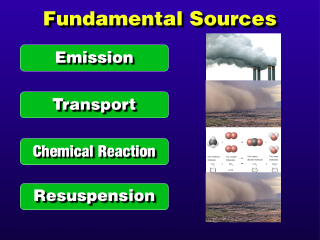
Air pollution sinks are the opposite of sources.
 |
One can come up with a pretty large list of air pollution sources,
especially for the anthropogenic ones. Note that the same processes and activities
can occur on both the natural and anthropogenic lists. On the anthropogenic
side, this means that humans are doing things that are enhancing the "natural"
emission of air pollutants. For example, commerical agriculture could increase
the emissions of gases associated with organic waste decay and the production
of dusts from plowed, dry fields.
Air pollution sinks are the opposite of sources. |
 |
Transport of pollutants involves air movement, or wind.
Resuspension is the opposite of deposition. The solid object (the ground, a wall, etc.) that can or will hold the pollutant gas molecules or aerosol particles does not need to be stationary--particles could collide and stick to a moving vehicle (deposition occurs) or be dislodged from the surface of the vehicle as air rushes past the moving vehicle (resuspension occurs). |
 |
Dispersion can involve air movement, such as the wind. This would be the opposite of the source process transport. Chemical reactions can use up a pollutant (and thus be a sink of that pollutant) and produce another pollutant (and thus be a source of that other pollutant). |